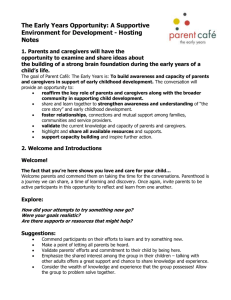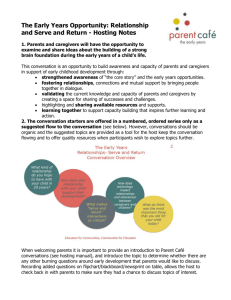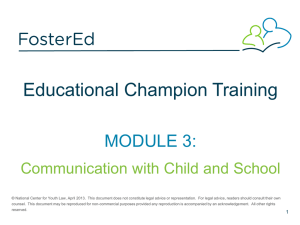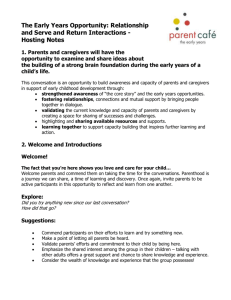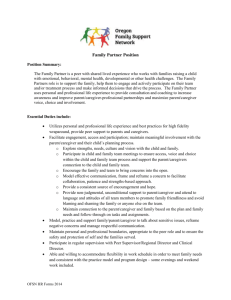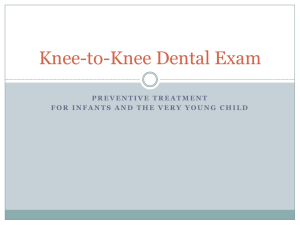The development of supportive environments for
advertisement
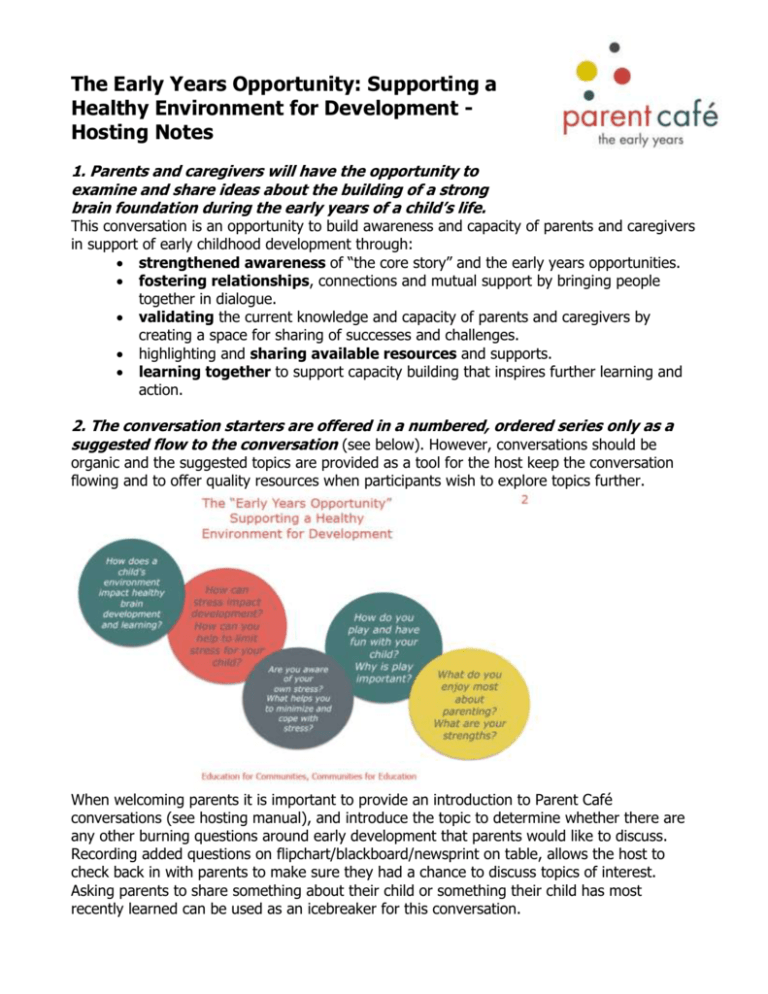
The Early Years Opportunity: Supporting a Healthy Environment for Development Hosting Notes 1. Parents and caregivers will have the opportunity to examine and share ideas about the building of a strong brain foundation during the early years of a child’s life. This conversation is an opportunity to build awareness and capacity of parents and caregivers in support of early childhood development through: strengthened awareness of “the core story” and the early years opportunities. fostering relationships, connections and mutual support by bringing people together in dialogue. validating the current knowledge and capacity of parents and caregivers by creating a space for sharing of successes and challenges. highlighting and sharing available resources and supports. learning together to support capacity building that inspires further learning and action. 2. The conversation starters are offered in a numbered, ordered series only as a suggested flow to the conversation (see below). However, conversations should be organic and the suggested topics are provided as a tool for the host keep the conversation flowing and to offer quality resources when participants wish to explore topics further. When welcoming parents it is important to provide an introduction to Parent Café conversations (see hosting manual), and introduce the topic to determine whether there are any other burning questions around early development that parents would like to discuss. Recording added questions on flipchart/blackboard/newsprint on table, allows the host to check back in with parents to make sure they had a chance to discuss topics of interest. Asking parents to share something about their child or something their child has most recently learned can be used as an icebreaker for this conversation. 3. For you, what was most important about our last conversation? Have you done anything differently since then? Creating a summary of key points from the last discussion is an opportunity to clarify questions, reinforce key points and summarize for parents that weren’t part of the first discussion. Suggestions: What made the biggest impression? What sparked you to try something new? Did you have the chance to share this information with others? Collecting the ideas that parents felt were most important as well as ways that they have integrated ideas and responded can spark further discussion and exchange. Recording these ideas can be helpful for further reflection and is very important for monitoring the impact of the conversations. The previous conversation highlights the importance of relationships in early development sa it relates to: Attachment, the emotional bond between a child and parents begins before birth and plays an important role in brain development. Relationships actually shape the architecture of the brain! Secure attachment impacts self confidence and independence, and lowers stress reactions. A loving, consistent caregiver can buffer a child from the negative impacts of stress. You may want to review the short video, particularly if there were parents that were not at the first conversation: Serve and Return Interaction Shapes Brain Architecture as a starting point for the conversation. Key points from this video focuses on the importance of ‘serve and return’ : Are part of an ongoing caregiver – child relationship. Are responsive to child reaching out. Are responsive to the individual child and their developmental needs in the moment. Build on child’s unique interests and capabilities. Shape the child’s self-awareness and sense of who they are in the world Buffer from stress response. Are an essential prerequisite for the development of healthy brain circuits and more complex skills! Are a key ingredient in forming relationships between young children, their parents and other caregivers, promoting healthy social, emotional, and cognitive development. 4. How does a child’s environment impact healthy brain development and learning? What should it include? …not include? Firstly, the physical needs of a child must be met to support optimal development, including sufficient sleep and rest, healthy nutrition, exercise and protection from physical harm. It is important to remember that conditions that may be tolerated by a mature brain can be toxic to a young, developing brain. A healthy environment is secure and predictable and includes a consistent, loving caregiver! Positive care giving can buffer a child from the impacts of stress! Early in a child’s life their brain is most plastic, or able to change and adapt as a result of their environment. This means a child’s brain is most susceptible to input, most vulnerable to harm and most capable of recovery at this time in their life! It is important to note with parents, however, that healthy relationships, environment and experiences continue to impact older children and healthy development – it is never too late, it is just harder work! The dance between genetic and environmental influences plays out as the genetic blueprint is read and interpreted, under the influence of the environment. A healthy environment is essential for a child to reach their optimal development! Explore: What is stressful for infants and young children? Infants and young children do experience stress in their day to day life from things including: A changing, unpredictable environment, something unexpected. Transitions from one situation to another. Parents feelings of stress, tone of voice and the manner they communicate, too many “no’s”. Not getting the attention and comforting that they are needing. Frustration from either their own or parents’ expectations. Its not just about bad things that happen but also good things that don’t happen! Lack of “serve and return” is stressful for a child. Read more: AFWI provides a summary of Brain Plasticity & Behavioral Change “Promoting children’s mental health is like using a sugar packet to level a table. The table can’t function properly if it is on a slanted floor or if one of its legs is uneven. Similarly, children can’t function fully if the environment in which they grow is unstable. This affects their mental health and undermines their development. The table can’t level itself: we have to step in and provide assistance to steady the table’s base. Source: Sharing the Brain Story, Alberta Family Wellness Initiative 5. Explore together this short video from the Centre on the Developing Child, Harvard University: Toxic stress Derails Healthy Development What are your reactions? What strikes you most? Some examples: Some stress is a normal part of life! “Positive stress”, or minor, short-lived stress events, like meeting new people, is a part of healthy development. Children learn to moderate and deal with stress through these experiences. High levels of prolonged stress without a loving caregiver can be “toxic” and derail healthy development, leaving a child with: changes in brain architecture. permanent “signatures” on genes. a more reactive stress response system increased lifelong risk of developing physical and mental health struggles, including addiction. children are less likely to explore, practice and learn new skills. Positive care-giving can protect and buffer a child from the impacts of stress. Even a traumatic life event, like a death in the family, doesn’t leave a lasting impact on the developing brain when a child is supported and nurtured by a consistent caregiver. Researchers call this “tolerable stress”. We know that infants and young children do experience stress, and that a stressful environment can have serious impacts on brain development. A secure and predictable environment with stable supportive relationships limits stress. Some stress is a normal part of life! Positive, or moderate, short-lived stress, causes a brief increase in heart rate and mild changes in stress hormones. Things like meeting new people or dealing with frustration are part of healthy development when a child has stable, supportive relationships. Toxic stress, high levels of prolonged stress experienced without the presence of a consistent, loving caregiver can derail healthy development, wiring a child to be very sensitive to stress, and vulnerable to develop physical and mental health struggles including addiction throughout their life. “The development of supportive environments for children is key to both reduce their exposure to toxic stress and create buffers of support to make stressful life events more tolerable.” -AFWI, Positive, Tolerable & Toxic Stress 6. Are you aware of your own stress? What helps you to minimize and cope with stress? Some healthy ways that parents cope with stress: Getting enough rest Eating well Physical exercise Spending time talking with friends Gardening, playing music, … Yoga and meditation Spiritual practice Others? 7. How can you help to limit stress for your child? Explore: Some stress is a normal part of life and part of healthy development! How can you support your child as they learn to moderate their own stress? There are many ways that parents can limit and help to moderate stress day to day aspects of parenting and care giving that can help to alleviate stress: Create an environment that feels safe and secure Follow predictable routines and regular patterns Bedtime routines help children transition and relax at the end of the day. Morning routines can help to get the day off to a good start. Offer warm, responsive care-giving, i.e. comforting our child when upset Communicate with a firm and kind voice, clear expectations and limits. Ensure our child gets enough rest and sleep – tired children are more easily stressed Make time for exercise and play time. Get outside. Provide healthy food that can helps children cope with stress more easily. Have realistic, developmentally appropriate expectations of their child Spend time with their child, showing them they are loved for who they are. Slowing down and turning off the technology. Have fun together and remembering to laugh! Learn to manage our own stress and model how you do this. Supporting children as they learn to manage their own stress response: Talk, talk, talk. Allow children to express what they feel and why. •Share strategies like “count to ten”, “breathing buddies” and “calming bottles” Stress is a normal part of life. The positive aspect of stresses such as meeting new people, adjusting to new situations, etc. is that it provides your child with opportunities to develop skills to learn to moderate their own stress. Suggested Resources: Kids Have Stress Too! Ideas, Tips and Strategies for Parents of Preschoolers from: The Psychology Foundation of Canada Suggestions from parents for managing stress: “Breathing Buddies” – Teaching Mindfulness to your Child “Calming Bottles” - http://mycrazyblessedlife.com/2011/10/03/relax-bottletime-out-timer/ 8. How do you play and have fun with your child? How is this supporting learning and development? We may not be thinking about it in the moment but the fun, playful activities that we share with children are great brain builders. A parents’ favorite ways to spend time with their children not only nurtures the bond they share with their child and builds feelings of competence and confidence as a parent, but also supports their child’s growth and learning. Having parents make the connection between their “fun” and the realms of development helps reinforce this. Suggested Activity: Have parents write down their ideas – one per sticky and match to the 5 areas of development. This activity helps parent to explore how everyday activities contribute to learning and development? Have parents write down their ideas of how they have fun together with their child (one per sticky. Post the 5 areas of development on a poster or white board and have parents match each idea to a key area of development that it supports). Examples: commuting on the bus together (communication and general knowledge) cooking (physical health and well-being, communication) swimming, (physical health and well being) playing hide and seek (language and thinking skills, physical health) Everyday activities can build a strong foundation for literacy in the early years: Babies brain lights up with reading, talking, singing and playing Communication and early literacy builds connections that support all aspects of development: Social, emotional, physical, cognitive Talking, reading, exploring, playing, and singing all support the development of foundational literacy skills. Encourage parents to find the joy in all these experiences they share with the child! Reinforce that parents support all areas of development when having fun together! Note: Many of the activities may overlap and support more than one area – use a best guess. Most important is to highlight the impact of ‘just playing” on all realms of development. Pinterest is a great place to find visual ideas and suggestions for having fun with our children. 9. Why is play so important? The words of Mr. Rogers, “Play is the work of childhood”) and Albert Einstein, “Play is the highest form of research,” are both consistent with what brain research and child development studies tell us: Play is an essential part of healthy development. Play isn’t a distraction or break from learning but really HOW children learn and develop! During play, a child’s brain takes in information using all five senses, creating and responding to sound, sight, touch, taste, and smell. These combine to create connections in the brain that help the child to make sense of the world and create the foundation for future learning and development. There is a role for structured play – but unstructured, independent play is important too; it helps children discover their own interests, develop focus, attention and imagination, problem solve, cope with frustration, plan and adapt. Play really is the ideal way to learn, tailored to a child’s interest and their individual developmental needs, promoting repetition and practice! Play provides opportunities to: rehearse, refine, practice and extend skills. Remember that brain connections (synapses) need repetition to strengthen! When its fun and interesting we are more likely to persist to repeat and extend our efforts. explore and learn to understand their environment and relationships build strong bonds with caregivers build understanding and thinking skills as we begin to make sense of the world build self esteem and confidence by doing things over and over and experiencing success. build connections in brain, supporting brain development and learning in all realms (physical, social, thinking, language, emotional) Creative play- executive function! Have fun! This of course inspires more exploration, repetition and learning! According to Stuart Brown ‘Play: How it Shapes the Brain, Opens the Imagination and Invigorates the Soul’ play has an an “essential role in fueling our intelligence and happiness throughout our lives.” Remember, you can still play too! Things that can “get in the way of play”: •More structured activities (sports, lessons) •Focus on academic activities for children •Lack of resources or family time •Television, electronics and media •Fewer safe areas where children can play Things we can do to promote play: • Incorporate play in daily activities – keep it fun! • Embrace free time • Turn off television of screens • Get outside with our children • Take the pressure off – limit structured activities Explore: For a more in depth look at play, share Stuart Brown’s Ted Talk: Play is more then just fun. Play: How it Shapes the Brain, Opens the Imagination, and Invigorates the Soul, by Stuart Brown and Christopher Vaughan (2010) Share this poem with parents: “Just Playing” by Anita Wadley 10. What are the best toys for infants and young children? The best toys for young children: Allow the child to explore and create. Provide opportunity for sensory stimulation. Are developmentally appropriate: provide an opportunity to practice and explore the skills a child is learning or refining. Are safe! Do not need to be expensive, electronic or complicated (think of a child on the floor with a cardboard box, pots and pans, plastic containers in the bath…..) Others? Explore: What are some common household objects that can be great play toys? building blocks, balls, dramatic play props, pots and pans, plastic containers… •Others? Share and discuss: Toys are also a way for us to enjoy, relate and build relationship with our children. In fact… a loving, responsive caregiver can be said to be a child’s “best toy”. (see Apple magazine). 11. Sharing your gifts and talents… What do you enjoy most about parenting? What do you find most challenging? Explore: Have parents explore their strengths in the context of: If “the best toy for baby is you”? – then what are the things that make this toy great? What are your strengths and talents? How can you share them? Have parents brainstorm their talents of the head, hands and heart (see activities: Gifts I can give my child and community*). Have parents note one idea per sticky note and add to wall chart. This question may help with the ideas: What do you like most about caring for a child? Examples: Love to sing – We sing silly songs together!” “I am very patient – I enjoy all the “why?” questions.” “I love to be active – We walks to the park and play soccer together.” Others…? Some points of discussion: Parents may need encouragement and examples - it can sometimes be difficult for adults to ‘blow their own horn”! By recognizing our own strengths we can find the joy in parenting! Parents have unique and diverse gifts and talents. There are many strengths even in this small group – if we think about our families, the entire community there are an amazing number of assets to draw on. Imagine if we shared our strengths and drew on all of each other’s strengths as opportunities for our children! Suggestion: end with another question: How do you share these strengths with other children? In your family, in your neighborhood, in your community? 12. After our discussion today, would you like to set a goal or try something new to support your child? What would you like to share with another parent or caregiver? Great ideas from parents: Try some of the breathing and calming strategies. Take the time to get down on the floor and play! Take time for myself to relax and relieve stress. Others? Reminder: provide any follow up information requested… Suggestions:
